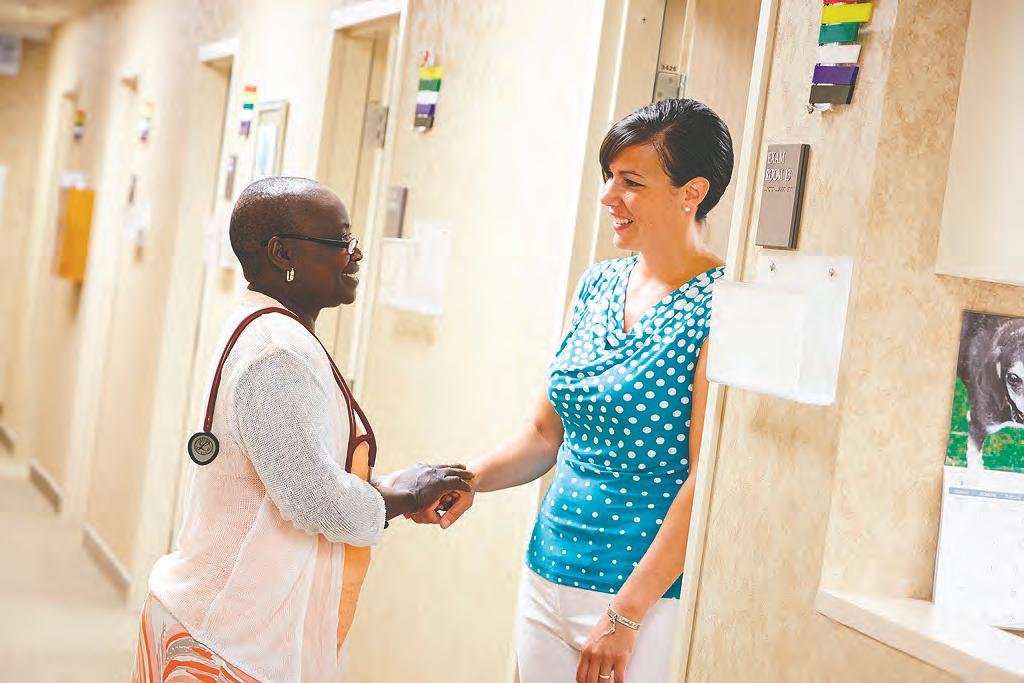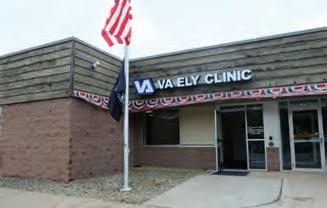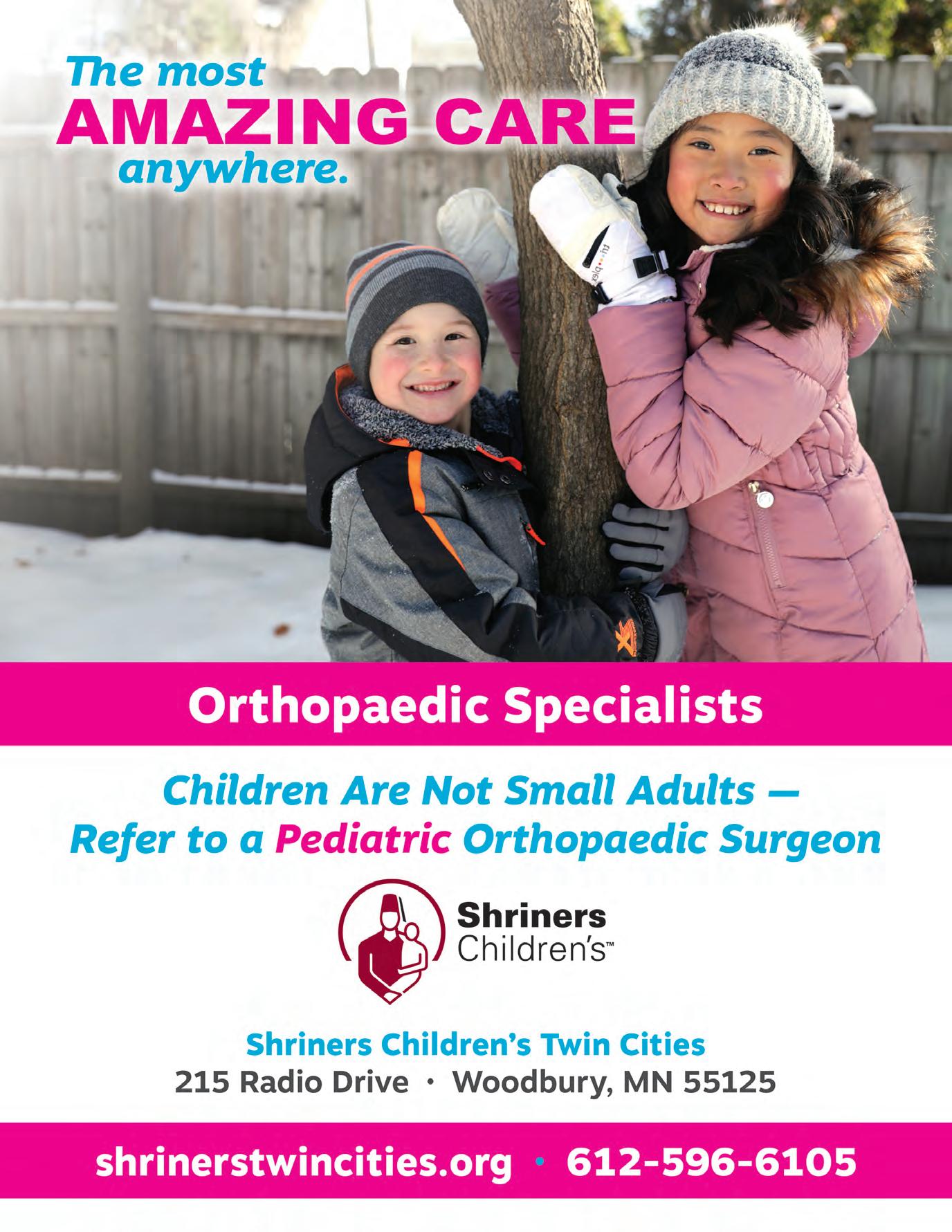
20 minute read
OPHTHALMOLOGY Where Eye Care Fits In
Where Eye Care Fits In
Bridging specialty and primary care
Advertisement
GARY S. SCHWARTZ, MD, MHA
When I was in medical school and matched in ophthalmology, a friend who is now a urologist started referring to me as an “eye dentist”. His logic was that because my patients would not need to undress and could be examined in a chair rather than a bed, that my practice would look more like a dentist’s than a physician’s. We laughed about this at the time, but throughout my training and career I have been repeatedly surprised by how often the truth behind his joke has shown through.
As with other specialties, the clinical, surgical, and business aspects of eye care have changed dramatically in the 30 years since I matched. Cataract surgery is still the most commonly performed surgical procedure in the United States, now is usually performed in physician-owned ambulatory surgery centers rather than hospitals. The use of lasers to “cure” patients of their dependence on eyelgasses has not only been proven effective and safe, but has also moved from the fringes of the eye care community to the mainstream. And advancements in eye care have not solely been surgical. For instance, there are now dozens of well-tolerated eyedrops available for the treatment of glaucoma, while in my residency there were only two or three, and each of these had its list of troublesome side effects. Despite all the medical and surgical advancements, eye care delivery is still fundamentally a combination of preventative and specialty care, where the concept of the “eye dentist” is at the root of the question, “Where does eye care fit into a patient’s overall health care?”
QualityTranscription,Inc.
Setting the standards for excellence
QualityTranscription(locatedinMinnesota) maintainsaprofessionalofficeenvironment, thustheconfidentialityofyourworkisstrictly maintained.Weprovidemedicaltranscription servicesonacontractoroverloadbasis. Ourequipmentisstateoftheartwith24hour dictationlinesandnationwideaccessibility. Weareexpertsinourfield.Wedeliveron time.Wehaveexperiencedstaff.Wemonitor thequalityofourwork. We provideservicestailoredtoyourneedsand willdowhateverittakestogetthejobdone.
QualityTranscription,Inc. 8960SpringbrookDrive,Suite110 CoonRapids,MN 55433 Telephone763-785-1115 TollFree800-785-1387 Fax763-785-1179 e-mailinfo@qualitytranscription.com Website www.qualitytranscription.com Eye Care as Primary Care

I am occasionally asked whether I consider myself a specialist or primary care doctor. I answer by saying that I am a primary care doctor for my patients’ eyes. In this regard, patients do not need to be referred to see me as they do for other types of specialists. Think about it – a patient with cardiac symptoms will usually be referred by their primary care provider (PCP) to a cardiologist. Likewise, a patient with GI symptoms will usually be referred by their PCP to a gastroenterologist. Although many patients are referred to me by their PCP’s, at least as many will find me on their own through advice of a friend, relative, or a Google search, and their PCP may never know that they were seen by me. Why is this?
I believe the answer to this question has to do with why the term “eye dentist” resonates. Most Americans know to see their dentist twice a year for cleanings and to give their dentist the opportunity to look for potential problems. Most of us keep to this schedule even though we are almost always asymptomatic. We also understand that what our dentist provides us is separate from and parallel to what our medical PCP does. They both take care of the parts of us that they are responsible for, usually without communicating with one another. There is a good chance your PCP does not know who your dentist is, and your dentist does not know who your PCP is.
For many of my patients, I perform the same type of service for their eyes that their dentist does for their teeth (minus the cleaning). Patients return to me on a schedule that I deem appropriate without either of us seeking input from their PCP. I update glasses and contact lens prescriptions (similar to a hygienist’s doing a cleaning) and look for signs of eye disease (much like a dentist’s looking for cavities). I usually will not send a letter back to the PCP for this type of service, and if I did, the PCP would likely not devote a lot of time to reading it. My patients remain fully clothed and are examined in a chair instead of a bed, exactly as my urologist friend predicted.
Another parallel with the dental profession lies in our ability to help PCP’s predict systemic disease. For instance, the status of the gums and teeth can allow dentists and hygienists to give feedback to PCP’s about their shared patient’s cardiovascular status. As eye doctors, we can do something similar. When we examine the posterior segment of a patient’s eye, it is the only time that a doctor can directly view that patient’s vascular system in vivo. In this way, we can often help diagnose vascular conditions such as hypertension, atherosclerotic disease, and diabetes mellitus before they even make it onto a patient’s problem list.
Eye Care as Specialty Care
Many eye doctors spend very satisfied careers engaged in the type of practice described above – the routine care of patients without significant disease. However, we are also trained as a specialist, and spend much of our time diagnosing and treating diseases such as glaucoma, uveitis, strabismus, cataract, macular degeneration, and so on. Many patients with disease are culled from our routine patient populations, while others are referred to us by their PCP’s. Once in our practices, some patients are best managed with surgical solutions (strabismus, cataract, retinal detachment, etc.), while others are better managed with medical ones (glaucoma, uveitis, dry eye, etc.).
Patients that need medical or surgical care will often share waiting-room space with routine ones, and most of our clinic schedules have a combination of both types of patients. What adds to the complexity is that some patients with mild medical problems (non visually-significant cataract, for example) will think of their exams as “routine”, and wonder why their visit may be coded as a medical one.
How Often Should Healthy Patients See an Eye Doctor?
We have established that eye doctors serve two functions for patients: (1) we are primary care doctors for their eyes, and (2) we medically and surgically manage eye diseases. One of our national organizations, The American Academy of Ophthalmology (AAO), has created the following recommendations for the timing of routine eye care in completely asymptomatic adults who do not require spectacle correction (eyeglasses or contact lenses):
Age (years) Frequency of Evaluation
Under 40 Every 5-10 years 40-54 Every 2-4 years
55-64 Every 1-3 years 65 and older Every 1-2 years
The main reason for us to perform scheduled eye examinations on otherwise healthy people is to discover problems early enough in the course of the disease that patients can be treated successfully. The analogy to dentistry is apt again. The dentist probes and x-rays to find small asymptomatic cavities that can be more easily treated while still in the early stages. If these cavities go undetected, they can lead to bigger problems that require more invasive and costly repairs, often with different definitions of success.
Dentists, of course, are not the only ones who understand the importance of testing asymptomatic people in order to catch diseases at stages that are more easily and successfully treatable. Blood pressure monitoring, routine bloodwork, colonoscopies, mammograms, and Pap smears are all examples of this strategy within medicine. The routine eye examination is just one more example of where someone is looking for early disease in populations of asymptomatic individuals.
The AAO schedule for routine eye exams is a rough guide, and many situations exist where patients should be seen more frequently. Diabetics,
Where Eye Care Fits In to page 184
Do you have patients with trouble using their phone due to a hearing loss, speech or physical disability?
Contact the Telephone Equipment Distribution Program for easier ways to use the phone. Phone: 800-657-3663 Email: dhs.dhhsd@state.mn.us Website: mn.gov/deaf-hard-of-hearing

The Telephone Equipment Distribution Program is funded through the Department of Commerce – Telecommunications Access Minnesota (TAM) and administered by the Minnesota Department of Human Services.



3Where Eye Care Fits In from page 17
retinopathy, age-related macular degeneration, and precancerous choroidal of course should be seen annually, along with patients on certain high-risk nevi. In each of these cases, early detection can lead to sight-saving, or even medications (most notably hydroxychloroquine). Anyone in eyeglasses or life-saving results. contact lenses should also be seen annually to have their prescriptions updated. Patients with Summary family histories of glaucoma, age related macular As eye doctors we are both primary care providers degeneration, early cataract, or many other for the eye, and specialists that PCP’s should significant causes of vision loss should also be seen more frequently than are listed above. Because of its asymptomatic nature and ability to cause irreversible vision loss, the single most Ophthalmologists are not only medical and surgical specialists, but also primary care doctors for the eyes. refer patients to for the medical and surgical management of diseases of and around the eye. Primary care providers should familiarize themselves with the recommendations for timing of routine eye examinations as published by the important reason to follow the AAO’s schedule for AAO, understanding that this schedule represents routine eye examinations is glaucoma. Glaucoma the bare minimum, and many patients with affects about one in every fifty Americans (3 specific situations should be seen more often than million people), is completely asymptomatic until what is listed here. Evaluating asymptomatic very late in the course of the disease, and is difficult to diagnose with the patients routinely is the single best way for us to not only diagnose and equipment available to the average PCP. Importantly, vision loss from treat asymptomatic eye diseases at stages when treatment is most effective, glaucoma cannot be reversed, so all treatment regimens are focused on the but also aid PCP’s in the diagnosis and management of many systemic prevention of vision loss, which is the opposite of cataract or wet macular diseases. For these reasons, PCP’s should refer their asymptomatic, healthy degeneration management, where treatment is based on the reversal of vision patients for eye exams in much the way they refer them for colonoscopies, loss. If we diagnose glaucoma in someone once they notice their vision loss, it is usually much, much too late for us to help them in a meaningful way. mammograms, and the like.
There are additional diagnoses that are also important to diagnose Gary S. Schwartz, MD, MHA, is President of Associated Eye Care, and early, while patients are still asymptomatic. Some of these include diabetic Co-Chair and Executive Medical Director of Associated Eye Care Partners.
BEFORE

REPURPOSING BIG BOX RETAIL FOR HEALTHCARE

EAPC converted a 33,000 SF retail store into a multi-specialty clinic based on the medical home model of care for Essentia Health in Park Rapids, MN
EAPC.NET/HEALTHCARE
Unique Practice Opportunity

Join an established independent internal medicine practice

Be your own boss in a collaborative business model with a healthcare philosophy that puts patients first and allows physicians to have complete control of their practice. The specialties we are looking for are:
Internal Medicine, Family Practice, Preventive Medicine, Cardiology, Dermatology, Allergist, or any other office-based specialty. Preferred Credentials are MD, DO, PA, and NP.
• Beautiful newly remodeled space in a convenient location • Competitive Wages and a great Professional Support Staff
Contact Mitchell for more information | mitch@brandtmgmt.com 6565 France Ave S Ste 350 Edina

with a Mankato Clinic Career
Established in 1916, physician-owned and led Mankato Clinic is 100 years strong and seeking Family Physicians for outpatient-only practices.
Over 50% of our physicians are involved in leadership positions and make decisions for our group. Full-time is 32 patient contact hours and 4 hours of administrative time per week. Four-day work week available. Clinic hours are Monday-Friday, 8 a.m.-5 p.m. OB is optional. Call is telephone triage, 1:17, supported by a 24/7 Nurse Health Line. Market-competitive guaranteed starting salary, followed by RVU production pay plan. Benefits include 35 vacation / CME Days annually + six holidays, $6,600 annual CME business allowance and a generous profit-sharing 401(k) plan. We’re just over an hour south of the Mall of America and MSP International Airport. If you would like to learn more about building a Thriving practice, contact: Dennis Davito Director of Provider Services 1230 East Main Street Mankato, MN 56001 507-389-8654 dennisd@mankatoclinic.com
Apply online at www.mankatoclinic.com
With more than 35 specialties, Olmsted Medical Center is known for the delivery of exceptional patient care that focuses on caring, quality, safety, and service in a family-oriented atmosphere. Rochester is a fast-growing community and provides numerous cultural, educational, and recreational opportunities. Olmsted Medical Center offers a competitive salary and comprehensive benefit package.
• Active Aging Services - Geriatric
Medicine/Palliative Care • Dermatology • ENT - Otology • Family Medicine • Gastroenterology • Pediatrics
• Psychiatry - Adult • Psychiatry - Child & Adolescent
• Rheumatology
Equal Opportunity Employer / Protected Veterans / Individuals with Disabilities
Send CV to: Olmsted Medical Center
Human Resources/Clinician Recruitment 210 Ninth Street SE, Rochester, MN 55904 email: dcardille@olmmed.org • Phone: 507.529.6748 • Fax: 507.529.6622 www.olmstedmedicalcenter.org
3Minnesota’s Medical Cannabis Program from page 15
Looking ahead
treatment can change their patients’ lives. Among the results for patients certified for intractable pain, for instance, practitioners reported on how medical cannabis While still prohibited under federal law, medical cannabis is legal in 36 treatment resulted in reducing dosage or eliminating medications that patients states and four territories, and cannabis can be used for pain. Between 2015 and 2017, of the 1,166 legally purchased by anyone over 21 years old in 15 MDH survey responses for intractable pain patients, states and three territories (South Dakota voters in nearly 60 percent of the practitioners reported a 2020 approved an amendment to legalize medical reduction of pain medications for their patients, with cannabis and adult-use cannabis in the state). Also 382 surveys (33%) indicating a decrease in opioid of note for Minnesota, in 2020 the Red Lake and Some patients were even medication for their patients. Some patients were White Earth nations approved medical cannabis able to eliminate opioid use. even able to eliminate opioid use. programs through referendum and are in the Whatever the future holds on possible process of standing up those programs. expansion of the program, health care practitioners
Policy discussions about legalizing adult use interested in participating are encouraged to visit of cannabis have picked up in Minnesota, with the Office of Medical Cannabis website at www. supporters citing racial disparities and criminal health.state.mn.us/medicalcannabis or email justice reform as some of the reasons for changing the law. health.cannabis@state.mn.us. The website provides information about how
Discussions are also taking place on the potential for expanding the state’s practitioners can enroll, which is done online and takes only a few minutes. Medical Cannabis Program, which is considered one of the most restrictive programs in the country. State law limits the program to two manufacturers and Nick Lehnertz, MD, MPH, MHS, is a medical specialist at MDH in the 16 Cannabis Patient Centers, and does not allow for use of medicine in plant Division of Infectious Disease Epidemiology, Prevention and Control. form. Advocates are expected to introduce a bill during the 2021 Minnesota Legislative session to allow plant form in the Medical Cannabis Program. Peter Raeker, MA, is the communications planner for the Office of Medical
What impact is the program having on its patients? MDH asks health care Cannabis at MDH. practitioners participating in the program to take note of how medical cannabis
Dr. Leah Schammel, Carris Health Physician

Carris Health
is the perfect match
Carris Health is a multi-specialty health network located in west central and southwest Minnesota and is the perfect match for healthcare providers who are looking for an exceptional practice opportunity and a high quality of life.
CURRENT OPPORTUNITIES AVAILABLE FOR BE/BC PHYSICIANS IN THE FOLLOWING SPECIALTIES:
• Anesthesiology • Dermatology • ENT • Family Medicine • Gastroenterology • General Surgery • Hospitalist • Internal Medicine • Nephrology • Neurology • OB/GYN • Oncology • Orthopedic Surgery • Psychiatry • Psychology • Pulmonary/
Critical Care • Rheumatology • Urology
Loan repayment assistance available.
FOR MORE INFORMATION:
Shana Zahrbock, Physician Recruitment Shana.Zahrbock@carrishealth.com (320) 231-6353 | carrishealth.com
3The Science of Culture from page 13
the overall leadership culture as a “1” (lowest score on the 1-7 scale) this class of respondents is also likely to rate 20 other key contributors to leadership culture at similarly low levels.
Relevance to a Governing Board
evaluation, and plans for its ongoing development. The state and status of the leadership culture should also represent an area of performance evaluation, and ongoing development for members of the senior leadership team. The governing board and the senior leadership team are viewed by the people of the organization as the guardians and keepers of the corporate culture. Let’s return to a foundational, going-in premise As physicians gain more insight into the science of the article; “trustees own the cultures of the of culture they become more able to effect positive organizations they govern.” To repeat, while change within their health systems, no matter trustees of healthcare organizations can’t be Mission performance how large or small. Better understanding of the expected to understand all the complexities is job #1 of governance. business dynamics that drive corporate decisionand intricacies of operating a hospital or health making allows them to be more active partners in system, they can be expected to understand, that process. in-depth, the state and status of the cultures of the organizations they govern. Why? Because, the culture of the organization will affect the Daniel K. Zismer, Ph.D. is Co-Chair and CEO of mission performance of the organization, and mission performance is job Associated Eye Care Partners, LLC, Also, Endowed Scholar, Professor Emeritus #1 of governance. and Chair, School of Public Health, University of Minnesota.
For trustees who accept the premise that a governing board owns organizational culture, the question of “what to do next” follows. The answer to the question lies with the right relationship with the CEO. The CEO is directly responsible to the board. Boards have responsibility and accountability for one employee; the CEO. Boards should engage with the CEO directly and routinely, on the state and status of the leadership culture of the organization, including its ongoing assessment and

Minneapolis VA Health Care System
Metro based opportunities include:
• Chief of General Internal Medicine • Chief of Cardiology • Cardiologist • Internal Medicine/Family Practice • Gastroenterologist • Psychiatrist • Tele-ICU (Las Vegas, NV) • Nephrologist Practice Opportunities throughout Greater Minnesota:
Our nation faces an unprecedented number of individuals who having served their country now receive health care benefits through the VA system. We offer an opportunity for you to serve those who have served their country providing community based health care in modern facilities with access to world-leading research and research opportunities. We provide outstanding benefits with less stress and burnout than many large system policies create. We allow you to do what you do, best – care for patients.

Ely VA Clinic
Current opportunities include:
Internal Medicine/Family Practice

Hibbing VA Clinic
Current opportunities include:
Internal Medicine/Family Practice
US citizenship or proper work authorization required. Candidates should be BE/BC. Must have a valid medical license anywhere in US. Background check required. EEO Employer. Possible Education Loan Repayment • Competitive Salary • Excellent Benefits • Professional Liability Insurance with Tail Coverage
For more information on current opportunities, contact: Yolanda Young: Yolanda.Young2@va.gov • 612-467-4964
One Veterans Drive, Minneapolis, MN 55417 • www.minneapolis.va.gov
3Restorative Justice from page 10
Four faculty members, across the research, education, and clinical missions, and two staff members from education and human resources completed training from the AAMC in December of 2020. The group who went through the training continues to meet monthly to plan where and when restorative circles can be incorporated into the work of the U of M Medical School.
The early experiences in the conduct of circles are revelatory. A patient-experiencefocused circle yielded a completely different understanding of what we “know” or what we expected. The participants and facilitators truly appreciated the stories, the insights into the perspectives of others, and the co-creation of new ideas to address the purpose of the circle.
I helped facilitate a circle focused on mentoring with another participating university in the AAMC training program. The circle consisted of an administrator, faculty members, and students. After meeting for one hour, the circle proposed an action plan of individual and organizational recommendations to improve mentoring at the institution. The participants went from nervous, anxious, and curious to motivated, excited, and grateful. The participants gained a better understanding of what faculty members and students experienced as mentees and, now, as mentors. They discussed ideals and what they wanted the future to look like. They talked about barriers and obstacles. They reached a common understanding they otherwise would never have obtained. That common understanding allowed them to quickly envision changes to improve the mentoring culture. Circles can also address specific issues of harm. People sometimes communicate things in the heat of the moment that they regret. There is the accidental reply all email, the all caps email, or the hurtful social media post where colleagues who are friends may see and feel hurt by a post. These are not infrequent events. Often the incident is buried, where it causes divisiveness, fuels factions, and perpetuates bad feelings. If the incident falls under human resources purview, a person may get “written up” or reprimanded for the behavior and threatened with sanctions.
Restorative justice provides an alternative to burying the incident. With careful preparation and facilitation, the victim can explain the impact of the comment. The person who said it can provide context for saying it, express regret and a desire to repair the damaged relationship. The victim can explain what it would look like to repair the harm. Of significance, the bystanders- those who witnessed the event, those who heard about it later, those who spread word of the incident - also get to tell their stories, describing the impact of the incident on them. People in support of the victim and for the person who caused harm can be engaged to help in rebuilding trust and in preventing future incidents. An understanding can be reached and actions agreed to, if appropriate for the situation.
Restorative justice in academic medicine can also involve reintegration of members who are separated from the school. Separation, whether due to leave, illness, or disciplinary action, can harm multiple groups of people within the separated person’s work community. The U of M Medical School hopes to one day be able to work with those separated from work to smooth re-entry.
In summary, restorative justice, practices, and approaches are not new. They will sound and feel familiar to many. Restorative practices differ from many processes currently used to address harm in that they focus on rebuilding relationships and healing instead of punitive approaches that separate people and do not build trust and community. Restorative practices are not for every situation though. The use of restorative practices in academic medicine is a valuable way to improve culture, repair harm, and reintegrate those members of the community who have been separated. Restorative practices are one way academic medicine can improve discovery, teaching, and the provision of care to better heal all those we serve.
Physician Coaching That Works!
Just as top professional golfers improve by hiring a swing coach, physicians can improve by hiring a professional coach. - Physician in Crisis? - Provider Suffering from Burnout? - Practice Partnership Challenges? - Develop Physician Leaders - Need to Improve Metrics? 24 years of experience have proven our evidence-based coaching consistently produces positive outcomes. Coaching Works! Even in the most challenging situations.

Call for a FREE consult.
Timothy R. McClernon, Ph.D. CEO, Managing Partner 612.321.8066 (cell)
Learn more: PeopleArchitects.com
Physician Coaching Leadership Coaching Clinical Team Building Amanda M. Termuhlen, MD is a Professor of Pediatrics and the Associate Dean for Faculty Affairs at the University of Minnesota Medical School. Dr. Termuhlen is also a pediatric hematologist/oncologist with University of Minnesota Physicians.




